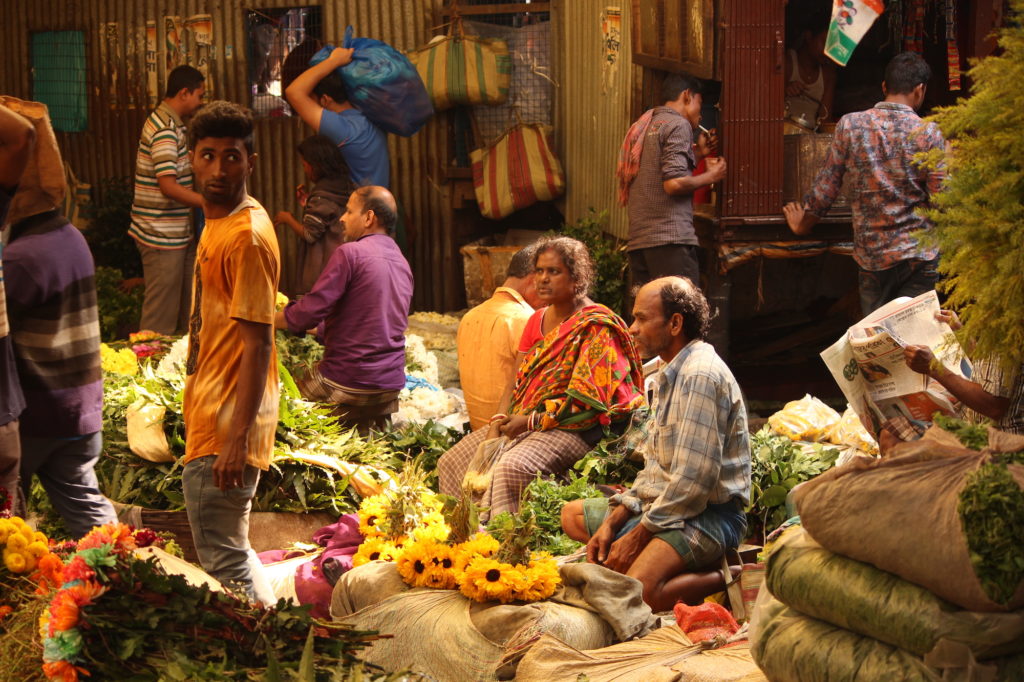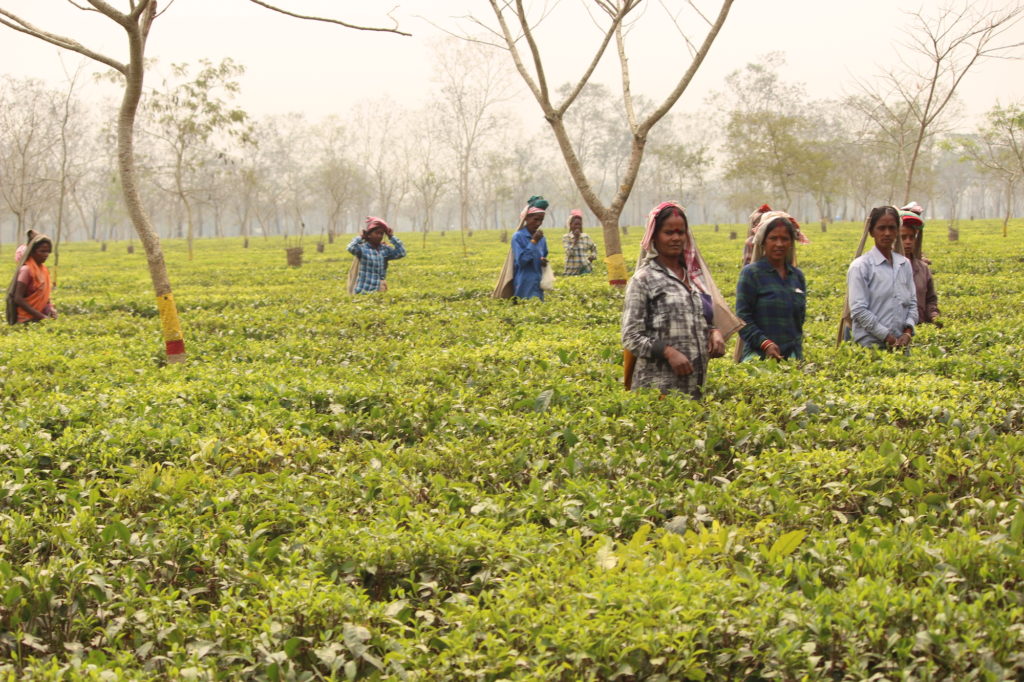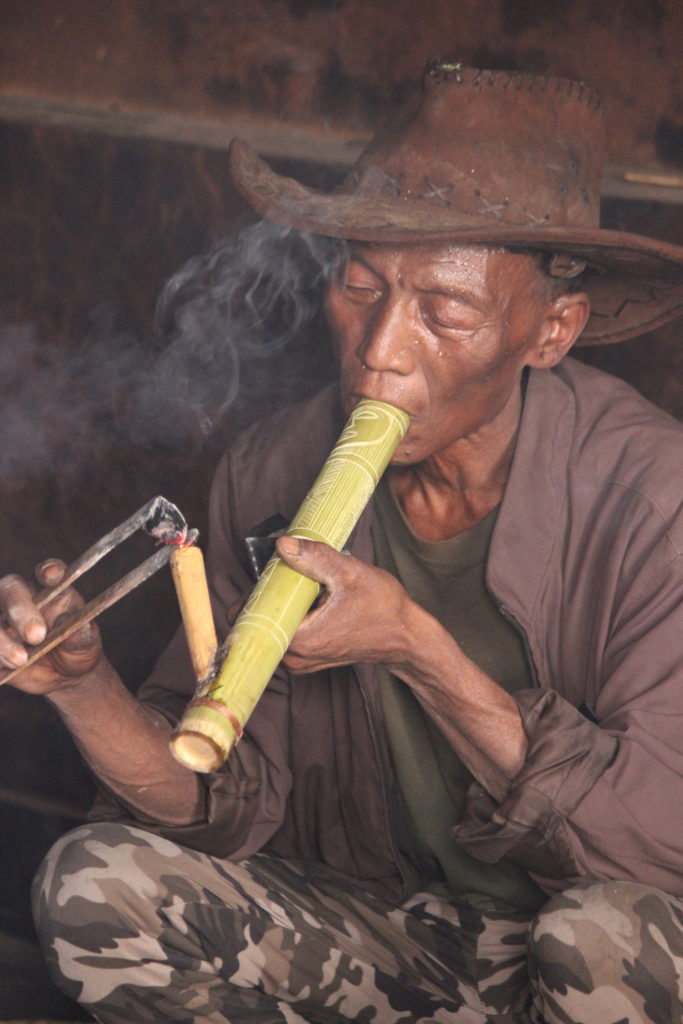I’d toured India before — five times — but never like this: no visits to the Taj Mahal, the holy Ganges River, the Red Fort. Instead, this three-week expedition introduced us to the people who invigorate this special land: the hard-laboring tea pickers, rice planters, rickshaw drivers, samosa vendors and tribal populations who enliven the vast subcontinent. That’s the mission of tour organizer Sudhakar (Sudha) Selwyn, whose passion is connecting with people, not merely visiting monuments.
Fresh off our flight, we began our introduction to Kolkata (formerly Calcutta) with a 6 a.m. trek through a nearby outdoor market, already bustling with water sellers balancing their buckets, guys on bikes to which dozens of complaining chickens were attached, skinny men hoisting 120-pound sacks of potatoes, fish sellers spreading their wares on a plastic-covered bit of pavement and sweepers attacking the tsunami of trash. We stopped for a quick breakfast of chapatis, lentils, spicy potatoes and richly sauced liver, along with a cup from a tea vendor (5 cents), before unpacking. Then, we were off to see the city.
While Delhi is India’s government center and Mumbai its economic hub, Kolkata lives up to its nickname: City of Joy. We gawked at men merrily bathing at a public spigot (BYO soap) not far from folks brushing teeth, getting haircuts and even defecating publicly (right on the sidewalk).
We barged into a hut, no bigger than a closet, of an untouchable-caste barber, his mother and wife, who cooks on the pavement for passers-by. We played with toddler orphans at Mother Teresa’s establishment. We made our way through a jasmine-scented labyrinth of flower sellers, emerging at a riverbank where the devout dipped into holy, murky waters.
Crossing a mighty bridge, along with what seemed like half of the city’s 17 million residents, we entered the iconic Hooghly railroad station, where homeless folks camped out amid the chaos. Then, we took a clattering tram to the booksellers’ quarter, stopping at the venerable India Coffee House, a hipsters’ hangout, for steaming cups served by elderly waiters in frilly white caps.
Throughout our trip, we took steps to avoid gastrointestinal mishaps, including sanitizing our hands and utensils, requesting food be heated up hot to order and avoiding fresh salads or already-peeled fruits, which allowed us to eat lots of oranges and bananas. We always opted for bottled water or, better, beer. (I’ve never had an issue on any of my six trips.)
We feasted in an elegant Bengali restaurant, in a modest Muslim café — biryani, lamb with mint, rice pudding — and in steamy street stalls plying sizzling samosas. We explored the temple of the bloodthirsty goddess Kali — incense, bells, crowds — and witnessed goat sacrifices via flashing scimitars in her honor.
We followed Sudha as he barged, unannounced yet again — and yet always welcome — into a nearby slum tenement, snaking through dusky corridors into many a family’s one-room hovel, clean as a whistle, boasting TVs but no water. Life is anything but easy in Kolkata. But smiles, a communal spirit and, yes, joy, indeed, prevail.
Soon, however, we were on to the real purpose of our journey — to explore the tribal way of life in the far northeast, India’s unvisited “wild frontier.” A short flight dropped us into the midst of tea-plantation country, where we lodged in modest guest houses and even more modest hotels (elusive electricity, rare hot water).
In the mountains, we followed the path of the powerful Brahmaputra River — driving across on a bridge lined with fish sellers from whom we bought what would become dinner. On foot, we traversed skimpy, swaying bamboo bridges and continued to a tribal village where we spent the day and night. They were ready for us: The ringleader, a spirited woman of a certain age, organized her peers to dance for us, then indicated we should do the same.
What? Now?
We hurriedly decided on the hokey pokey, which made a big hit. The tribal ladies giggled as they put their whole selves in. Followed by a growing herd of children, Pied Piper-style, we visited their homes and joined in a communal lunch of rice, chicken and egg pudding cooked in hollow bamboo logs over an open fire, accompanied by rice beer — a decidedly acquired taste.
We later supped on rice and spinach aside the open fire, and then bedded on the floor at sunset, to be awakened by rowdy chickens at 5 a.m. The tribes had no written language and spoke no Hindi — the sorta-universal tongue of India — yet sported polished toenails and trendy torn jeans (for the teens). They’re ardent animists. We joined their worship service of chant-and-response on a sunny Sunday.
Hitting the hairpin-turn highway through the jungle, we stopped for a couple of elephants and their construction-worker mahoots (drivers) and at roadside stands selling local mandarins and bananas, admiring the babies of the bread-winning moms. Their husbands, we later discovered, had adjourned to the local outdoor bingo parlor for an afternoon of gambling (a winner got a coveted Harley).
As we drove, we watched Army troops learning to raft in the mighty river, and then braked to chat with teenagers headed to town to deliver smoked meat to their elders. Oh, what kind of meat, asked Sudha: “Show us.” Songbirds. Mice on a skewer.
In Pasighat, our town for the night, we ambled through market stalls, admiring exotic fruits and veggies, and then encountered one of India’s wandering ascetics — a young man given by his parents at age 5 to the religious life of begging for food and sleeping in temples. He joined us in another round of samosas.
In Assam, we invited ourselves yet again into the city’s slums, where everyone smilingly posed for photos, let us hold their babies and invited us into their colorful rooms. On the banks of the river, we saw women maneuvering a huge net attached to 2-by-4s to catch what looked like minnows for their lunch. Passing one of the many aged trucks — decorated in tinsel, Christmas lights and portraits of gods galore — we came upon crowds streaming into a huge pavilion, all in their best shirts and saris.
What’s going on, we asked? It was the annual tribal political-social gathering, we were told by the officials, who whisked us (again unannounced) straight to the VIP tent for tea and cookies. We were then ushered to front-row seats for a dance performed gracefully by 200 sari-clad teenagers. Phone cameras clicked — we were now used to the constant demand for selfies — as we were presented with ceremonial shawls. A teenage boy whispered in awe, “You are my first foreigner!”
We were everybody’s first. This region receives few tourists — Indian or foreign — so we were treated like royalty. We visited a vast rice paddy to talk to the women whose back-breaking job it is to pluck the stalks and put them into sacks. We shook their rough, scarred hands, posed for more selfies, and then stopped at a tea stand down the road — which, of course, caused cars and scooters to stop and ogle the white-skinned visitors.
Nearby stood a schoolyard, so we strolled in to take a peek. Immediately, waving kids filled the windows, and then burst out the doors, followed by their equally excited teachers. The middle-schoolers danced for us and tested their English (“Nice to meet you.”), followed by more tea and cookies and again a ceremonial scarf from the teachers, plus hugs and kisses as we departed.
That night, we stayed at the Victorian home of a former British plantation bigwig and dined on tasty cauliflower, mutton, paneer (a wonderful soft cheese, often served with spinach) eggplant, squash, potatoes, those tiny river minnows and — yes! — ice cream.
The next morning, we were off to Nagaland, which made the earlier part of our journey appear tame. We drove higher, higher, on the always-winding and supremely bumpy roads until we reached a guest house in — surprise — a Baptist village, where the locals were converted by British missionaries long ago and now are building a 5,000-person church.
Journeying on to Sivasagar — Lord Shiva’s Town — we visited the god’s temple to watch priestly rituals and receive blessings before we wandered the grounds (more selfie requests). The middle-class homes that lined the road were painted with an Indian’s delight in color: saffron with bright orange, lavender accents on royal blue, candy-cotton pink paired with mint green. The lower classes meanwhile occupied, as always, plain bamboo shacks.
In Nagaland, we were quick to sense a difference in lifestyle and in attitude. The children had a dull, glazed demeanor; 5-year-old girls tended babies strapped to their backs. Grownups, too, failed to smile and converse. We were merely tolerated. The reason? Opium.
We entered the building owned by the tribal king, whose brother was occupied smoking opium. We watched, mesmerized, but didn’t accept his invitation to join in. The headhunter tribe we visited — no longer naked and no longer hunting heads — displayed the feathered headdresses and the chest tattoos that boasted of their former prowess. There was a distinct Mongolian cast to their faces, their land so close to Myanmar, which we entered just to say we did. The Army post had a “No Photos” sign, but the soldiers inspecting our van brought out their phones.
Retracing the route to our village, we encountered the only scary moment of the trip: the billowing smoke and crackling flames of a forest fire quickly speeding toward us. Sudha’s quick thinking saved the day as we retreated, and then made a dash along the smoldering road.
Next, we were off to Kaziranga National Park, a 200-square-mile preserve, where we rode elephants at dawn to observe thousands of rhinos, deer, wild boar, wild buffalo, monkeys, lizards and birds. Though 120 tigers are also protected in the reserve (despite the efforts of poachers), we failed to spot a single one.
Last stop: Guwahati, a town known for its ebullient celebration of Holi, “the festival of colors.” Colors mean paint, water-pistol-sprayed or plastered onto anyone and everyone around. We donned old clothes for the experience, and then made our way through the families gathered at the temple (another goat sacrifice to observe — or not), as our faces, hair and garments turned bright green, purple and beyond. After a final round of selfies, it was time to fly home, laden with experiences we’ll always remember.
To do the same, learn more on Sudha’s website or just write him at [email protected]. Then get going. Lucky you!

Carla Waldemar is an award-winning food/travel/arts writer. She edits the annual Zagat Survey of Twin Cities restaurants and writes food and travel articles for publications around the world. She lives in Uptown.







